Spatial and Temporal Patterns of Hydropower Development on the Qinghai–Tibet Plateau
Abstract
1. Introduction
2. Materials and Methods
2.1. Study Area
2.2. Evaluation Indicators
- (1)
- Hydropower development density:D is the density of hydropower development, is the total number of hydropower stations on a river in a county, and L is the length of the river in the county in km. The data were obtained from the national 1:250,000 tertiary water basin data set by county statistics.
- (2)
- Strength of hydropower development:I is the development strength of hydropower in the county in MW/km2, is the installed capacity of the number-i th hydropower station in the county in kW, and A is the county area in km2.
2.3. Evaluation Index Classification
2.4. Exploratory Spatial Data Analysis
2.4.1. Global Spatial Autocorrelation
2.4.2. Local Spatial Autocorrelation
2.5. Data
3. Results and Analysis
3.1. Hydropower Development Process
3.1.1. Number of Hydropower Stations
3.1.2. Installed Hydropower Capacity
3.1.3. Hydropower Development Stage
3.2. Density and Intensity of Hydropower Development
3.2.1. Hydropower Development Density
3.2.2. Strength of Hydropower Development
3.3. Spatial Analysis of Hydropower Development Pattern
3.3.1. In the Past 40 Years, the Spatial Distribution and Clustering of Hydropower Development Has Been Further Enhanced
3.3.2. Obvious Aggregation Effect in the Eastern Margin Area
4. Discussion
4.1. Scientific Method
4.2. Policy Implication
4.3. Limitations and Prospects
5. Conclusions
- (1)
- We analyzed the evolution of hydropower development on the Qinghai–Tibet Plateau and found that, in the past 40 years, hydropower development has been growing continuously, and that the time around 2005 was a key period of “quantity growth”, while 2014 was a key period of “installed capacity growth”. Hydropower development on the Qinghai–Tibet Plateau has made a leap from quantitative development to qualitative development.
- (2)
- We evaluated the density and intensity of hydropower development on the Qinghai–Tibet Plateau in the past 40 years and found that the development in this region is mainly concentrated in the eastern margin, and the degree of hydropower development in most other regions is still very low. The hydropower development on the Qinghai–Tibet Plateau will continue for a period of time in the future, which will lead to a significant increase in the intensity in some regions. Such development needs to pay great attention to the ecological environment protection in these regions, and the pattern of hydropower development on the plateau should be optimized on the whole.
- (3)
- From the perspective of global space autocorrelation, the distribution of the Qinghai–Tibet Plateau hydropower development shows high space autocorrelation, and the high density and high intensity areas of hydropower development are clustered in the east and south, and the global space autocorrelation index shows that it will continue to strengthen over time; this means a high hydropower development scale when the adjacent counties’ development scale is high, and vice versa. The implication of this conclusion is that the imbalance of hydropower development on the Qinghai–Tibet Plateau is increasing. If we do not pay attention to this phenomenon and effectively adjust the regional policies, the agglomeration of hydropower distribution in the eastern regions will become more obvious, which will lead to the reduction of water resources in the concentrated areas and serious damage to the ecological environment. Limited by natural, economic, technological and other factors, hydropower development in the western part of the Qinghai–Tibet Plateau is difficult to improve, making it impossible to maintain equilibrium on the Qinghai–Tibet Plateau. Therefore, it is necessary to appropriately reduce hydropower generation in high-intensity development zones, mitigating the impact of water diversion and power generation on the ecological environment. Considering that the Qinghai–Tibet Plateau is rich in wind and solar energy resources. The technical exploitable amount of wind energy resource was 1.02 billion kw, accounting for 26% of the national total. The total annual radiation amount of solar energy is 0.5–1 times that of the plain area at the same latitude. Moreover, the investment cost and operation cost of wind and solar energy are lower than the construction cost of hydropower development, and the pollution to river ecological environment is less than that of hydropower development. Therefore, we can make good use of wind, solar and other clean energy sources to realize better development of clean energy. However, there are random and uncontrollable defects in wind power generation and photovoltaic power generation, and electric power transportation is difficult. Therefore, it is still necessary to ensure the leading roles of hydropower development. Then, according to the actual situation in the region, photovoltaic power generation and wind power generation will be proportionally allocated [48,49]. The “Power Sky Road” Qinghai–Tibet Network project and the ultra-high-voltage transmission line project will be utilized to realize external transmission of electric power.
- (4)
- From the perspective of local space autocorrelation, “high” clusters are mainly concentrated in the eastern region of the Qinghai–Tibet Plateau, and “low-high” clusters and “high-low” clusters gradually decreased after 2000. This shows that the Qinghai–Tibet Plateau hydropower development aggregation effect is emerging, and the concentration of hydropower stations is on the increase, while the “hot spot” effect of hydropower development distribution is weakening. An important implication of this conclusion is that if the development level of the eastern margin region is further expanded, more hydropower stations will concentrate here in future. The most likely result is the further expansion of the development scale, which leads to the adverse development of the regional environment, and the unreasonable development will eventually lead to regional disharmony.
Author Contributions
Funding
Institutional Review Board Statement
Informed Consent Statement
Data Availability Statement
Conflicts of Interest
References
- Lao, C.Y. A Study on Regional Economic Impact of Hydropower Development in Tibet. Financ. Mind. 2016, 1, 86–97, 138. (In Chinese) [Google Scholar]
- Xie, J.Y.; Tang, W.J.; Yang, Y.H. Fish assemblage changes over half a century in the Yellow River, China. Ecol. Evol. 2018, 8, 4173–4182. [Google Scholar] [CrossRef]
- Yuan, B.; Guo, M.; Wu, W.; Zhou, X.; Xie, S. Geochemical Fractions and Release Characteristics of Nitrogen in Sediments Along Deep-Water Cascade Reservoirs of the Lancang River. Environ. Eng. Sci. 2022, 39, 364–378. [Google Scholar] [CrossRef]
- Xia, M.; Jia, K.; Zhao, W.; Liu, S.; Wei, X.; Wang, B. Spatio-temporal changes of ecological vulnerability across the Qinghai-Tibetan Plateau. Ecol. Indic. 2021, 123, 107274. [Google Scholar] [CrossRef]
- Zhang, L.; Pang, M.; Wang, C.; Ulgiati, S. Environmental sustainability of small hydropower schemes in Tibet: An emergy-based comparative analysis. J. Clean. Prod. 2016, 135, 97–104. [Google Scholar] [CrossRef]
- Qiao, H.; Huang, Z.; Chen, W.; Zhang, C.; Ou, C.; Zhang, S. Development of small hydropower in China 1990–2015: Province-domain patterns of temporal-spatial evolution. J. Renew. Sustain. Energy 2019, 11, 055903. [Google Scholar] [CrossRef]
- Yang, Y.j.; Zhang, C.D. Key Aspects of the Future Hydropower Development in China. Hydropower New Energy 2021, 35, 1–7. (In Chinese) [Google Scholar]
- Chen, S.; Chen, B.; Su, M. An estimation of ecological risk after dam construction in LRGR, China: Changes on heavy metal pollution and plant distribution. Procedia Environ. Sci. 2011, 5, 153–159. [Google Scholar] [CrossRef]
- Qian, G.L. Hydropower Development and Environmental Protection in Tibet Autonomous Region. Water Power 2019, 45, 6–10, 34. (In Chinese) [Google Scholar]
- Mu, Y.; Xu, P.; Fu, B.; Li, M. Impact of Hydropower Development in Upper Reaches of Minjiang River on Flow Reducing of River Reaches. Yangtze River 2015, 46, 67–71. (In Chinese) [Google Scholar]
- Li, Z.X.; Lv, L.L.; Li, P. Evaluation of Impact of Hydropower Exploitation on River Ecological Environment in Tibet. J. Hohai Univ. (Nat. Sci.) 2014, 42, 200–204. (In Chinese) [Google Scholar]
- Guo, C.; Ma, G.; Xiao, H.; Zhou, W.; Chen, H.; Zhou, Z.; Cheng, X. Displacement Back Analysis of Reservoir Landslide Based on Multi-Source Monitoring Data: A Case Study of the Cheyiping Landslide in the Lancang River Basin, China. Remote Sens. 2022, 14, 2683. [Google Scholar] [CrossRef]
- Xing, Y.; Bai, J.; Li, H.; Liu, B.; Zhao, Y. Species diversity of fishes in the Dingqu River Basin, tributary of the upper Yangtze River, China. Biodivers. Data J. 2021, 9, e76669. [Google Scholar] [CrossRef]
- Zhai, H.; Hu, B.; Luo, X.; Qiu, L.; Tang, W.; Jiang, M. Spatial and temporal changes in runoff and sediment loads of the Lancang River over the last 50 years. Agric. Water Manag. 2016, 174, 74–81. [Google Scholar] [CrossRef]
- Li, J.; Dong, S.; Yang, Z.; Peng, M.; Liu, S.; Li, X. Effects of cascade hydropower dams on the structure and distribution of riparian and upland vegetation along the middle-lower Lancang-Mekong River. For. Ecol. Manag. 2012, 284, 251–259. [Google Scholar] [CrossRef]
- Liu, Y.; Lu, H.; Tian, P.; Qiu, L. Evaluating the effects of dams and meteorological variables on riparian vegetation NDVI in the Tibetan Plateau. Sci. Total. Environ. 2022, 831, 154933. [Google Scholar] [CrossRef] [PubMed]
- Li, T.; Huang, X.; Jiang, X.; Wang, X. Assessment of ecosystem health of the Yellow River with fish index of biotic integrity. Hydrobiologia 2018, 814, 31–43. [Google Scholar] [CrossRef]
- Su, T.; Wang, S.; Mei, Y.; Shao, W. Comparison of channel geometry changes in Inner Mongolian reach of the Yellow River before and after joint operation of large upstream reservoirs. J. Geogr. Sci. 2015, 25, 930–942. [Google Scholar] [CrossRef]
- Guo, X.; Zhu, X.; Yang, Z.; Ma, J.; Xiao, S.; Ji, D.; Liu, D. Impacts of cascade reservoirs on the longitudinal variability of fine sediment characteristics: A case study of the Lancang and Nu Rivers. J. Hydrol. 2020, 581, 124343. [Google Scholar] [CrossRef]
- Chen, J.; Mei, Y.; Ben, Y.; Hu, T. Emergy-based sustainability evaluation of two hydropower projects on the Tibetan Plateau. Ecol. Eng. 2020, 150, 105838. [Google Scholar] [CrossRef]
- Chen, L.; Huang, K.; Zhou, J.; Duan, H.-F.; Zhang, J.; Wang, D.; Qiu, H. Multiple-risk assessment of water supply, hydropower and environment nexus in the water resources system. J. Clean. Prod. 2020, 268, 122057. [Google Scholar] [CrossRef]
- Cui, B.; Hu, B.; Zhai, H. Employing three ratio indices for ecological effect assessment of Manwan Dam construction in the Lancang River, China. River Res. Appl. 2011, 27, 1000–1022. [Google Scholar] [CrossRef]
- Tang, J.Y.; Shi, Z.R. Research on the Hydropower Development Ideas of Jinsha River. China Water Resour. 2004, 16, 33–34. (In Chinese) [Google Scholar]
- Deng, C.; Zhang, W. Spatial distribution pattern of degree–day factors of glaciers on the Qinghai–Tibetan Plateau. Environ. Monit. Assess. 2018, 190, 475. [Google Scholar] [CrossRef] [PubMed]
- Liang, L.; Li, L.; Liu, C.; Cuo, L. Climate change in the Tibetan Plateau Three Rivers Source Region: 1960-2009. Int. J. Clim. 2013, 33, 2900–2916. [Google Scholar] [CrossRef]
- Ren, Z.; Jiang, Z.; Cai, Q. Longitudinal patterns of periphyton biomass in Qinghai–Tibetan Plateau streams: An indicator of pasture degradation? Quat. Int. 2013, 313–314, 92–99. [Google Scholar] [CrossRef]
- Li, M.; Fu, B.; Wang, Y.K.; Peng, P.H.; Yan, K. Characteristics and Spatial Patterns of Hydropower Development in the upper Minjiang River Basin. Resour. Environ. Yangtze Basin. 2015, 24, 74–80. (In Chinese) [Google Scholar]
- Ptak, T.; Crootof, A.; Harlan, T.; Kelly, S. Critically evaluating the purported global “boom” in small hydropower development through spatial and temporal analysis. Renew. Sustain. Energy Rev. 2022, 163, 112490. [Google Scholar] [CrossRef]
- Zhou, X.; Fan, S.Y.; Sun, H.; Tang, L.; Ma, F.W. Practices of environmental protection, technological innovation, economic promotion and social equity in hydropower development: A case study of cascade hydropower exploitation in China’s Dadu River basin. Clean. Technol. Envir. 2021, 23, 2827–2841. [Google Scholar] [CrossRef]
- Gao, J.; Yao, F.M.; Lei, X.H.; Wang, J.X.; Ma, F.P. Study on water quality evaluation and water quality distribution characteristics of main stream of Daduhe River under the background of cascade hydropower development. Water Resour. Hydropower Eng. 2021, 52, 133–145. (In Chinese) [Google Scholar]
- Laurent, T.; Ruiz-Gazen, A.; Thomas-Agnan, C. GeoXp: An R Package for Exploratory Spatial Data Analysis. J. Stat. Softw. 2012, 47, 1–23. [Google Scholar] [CrossRef]
- Dall’erba, S. Distribution of regional income and regional funds in Europe 1989–1999: An exploratory spatial data analysis. Ann. Reg. Sci. 2005, 39, 121–148. [Google Scholar] [CrossRef]
- Kong, H. Surface Domain Spatial Autocorrelation Analysis of per Unit Area Yield of Grain. IOP Conf. Ser. Mater. Sci. Eng. 2018, 381, 012037. [Google Scholar] [CrossRef]
- Moran, P.A.P. The Interpretation of Statistical Maps. J. R. Stat. Soc. Ser. B Methodol. 1948, 10, 243–251. [Google Scholar] [CrossRef]
- Patricia, A.E.; Astorkiza, I. From Exploratory Data Analysis to Exploratory Spatial Data Analysis. Math. Stat. 2020, 8, 82–86. [Google Scholar]
- MacIndoe, H.; Oakley, D. Encouraging a Spatial Perspective in Third Sector Studies: Exploratory Spatial Data Analysis and Spatial Regression Analysis. Volunt. Int. J. Volunt. Nonprofit Organ. 2023, 34, 64–75. [Google Scholar] [CrossRef]
- Arthur, G. Cliff, A.D. and Ord, J.K. 1973: Spatial autocorrelation. london: Pion. Prog. Hum. Geoc. 1995, 19, 245–249. [Google Scholar]
- Anselin, L. Local indicator of spatial assocation-LISA. Geogr. Anal. 1995, 27, 93–115. [Google Scholar] [CrossRef]
- Editorial Board of China Hydropower Yearbook. China Hydropower Yearbook; China Electric Power Press: Beijing, China, 2006. (In Chinese)
- General Administration of Hydropower Construction, Ministry of Electric Power Industry, The Law of the People’s Republic of China (Basin) Water Resources Review Results (2003); Ministry of Electric Power Industry: Beijing, China, 2003. (In Chinese)
- General Administration of Hydropower Construction, Ministry of Electric Power Industry, The Law of the People’s Republic of China (Province) Hydropower Resources Review Results (2003); Ministry of Electric Power Industry: Beijing, China, 2003. (In Chinese)
- Editorial Department of Tibet Yearbook. Tibet Yearbook; Tibet People’s Publishing House: Lhasa, China, 2000. (In Chinese)
- Compilation Committee of the English Edition of the Sichuan Yearbook. In Sichuan Yearbook (English Version); Chongqing CEC Electronic Audio and Video Publishing Co., Ltd.: Chongqing, China, 2015.
- Jiao, L. Second Comprehensive Scientific Expedition to the Qinghai-Tibet Plateau; China Forestry Publishing House: Beijing, China, 2020; Volume 319. (In Chinese) [Google Scholar]
- Wang, M.L. Preliminary Assessment of River Health for Hydropower Development in the Hengjiang River Basin. In Proceedings of the Water Ecology (7th) China Water Ecological Conference 2019, Enshi, China; 2019; pp. 168–172. (In Chinese). [Google Scholar]
- Napalasawang, K.; Mi, B.Y.; Chen, X. Assessment of hydrological elements for hydropower development in southern Laos. Water Resour. Hydropower Express Rep. 2016, 37, 25–28. (In Chinese) [Google Scholar]
- Cao, J.T.; Qin, D.h.; Kang, E.S.; Li, Y.Y. Runoff changes of major rivers in the outflow area of the Qinghai-Tibet Plateau. Sci. Notif. 2005, 21, 2403–2408. (In Chinese) [Google Scholar]
- Zhang, Y.; Lian, J.; Ma, C.; Yang, Y.; Pang, X.; Wang, L. Optimal sizing of the grid-connected hybrid system integrating hydropower, photovoltaic, and wind considering cascade reservoir connection and photovoltaic-wind complementarity. J. Clean. Prod. 2020, 274, 123100. [Google Scholar] [CrossRef]
- Zhang, Y.; Ma, C.; Yang, Y.; Pang, X.; Lian, J.; Wang, X. Capacity configuration and economic evaluation of a power system integrating hydropower, solar, and wind. Energy 2022, 259, 125012. [Google Scholar] [CrossRef]
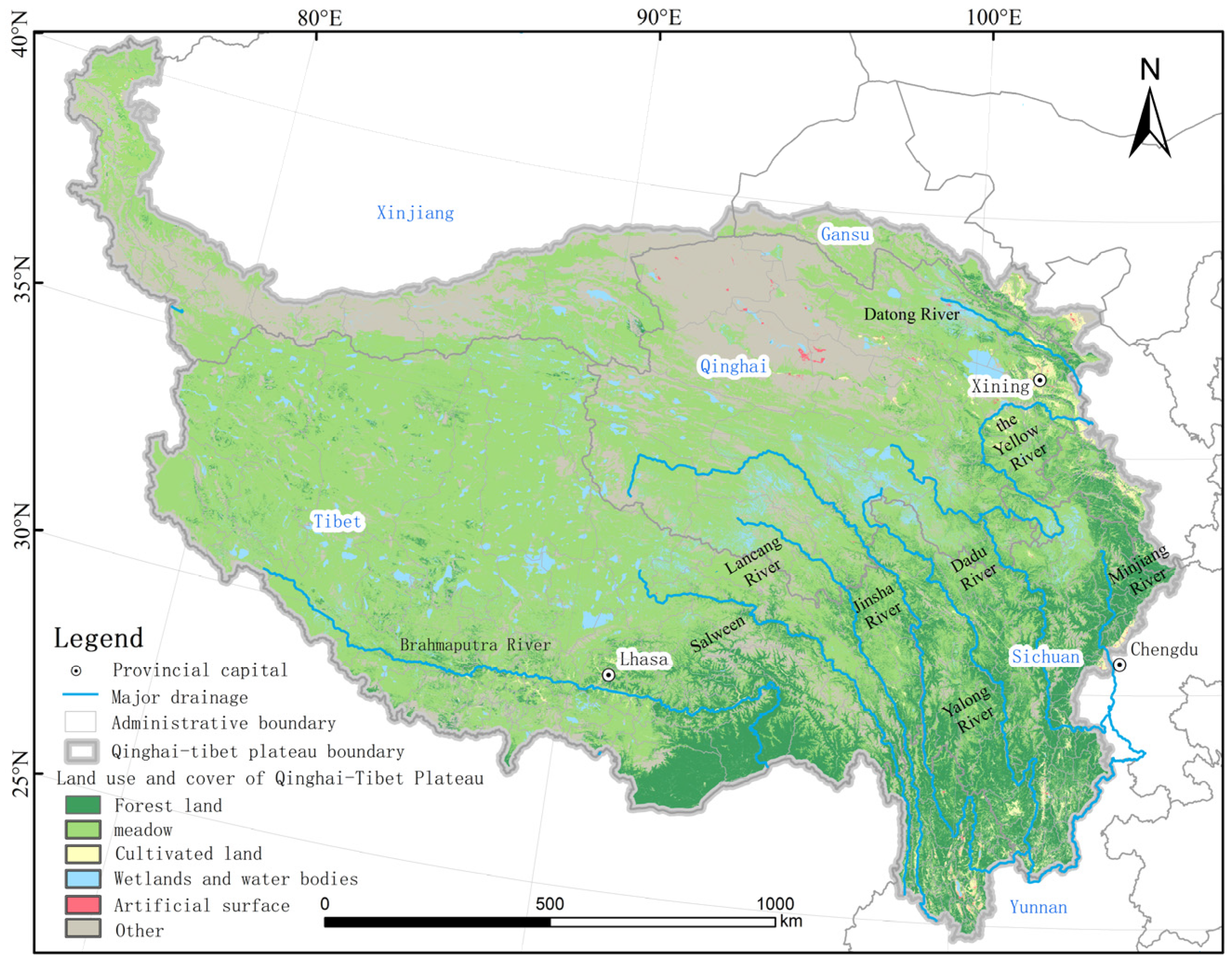
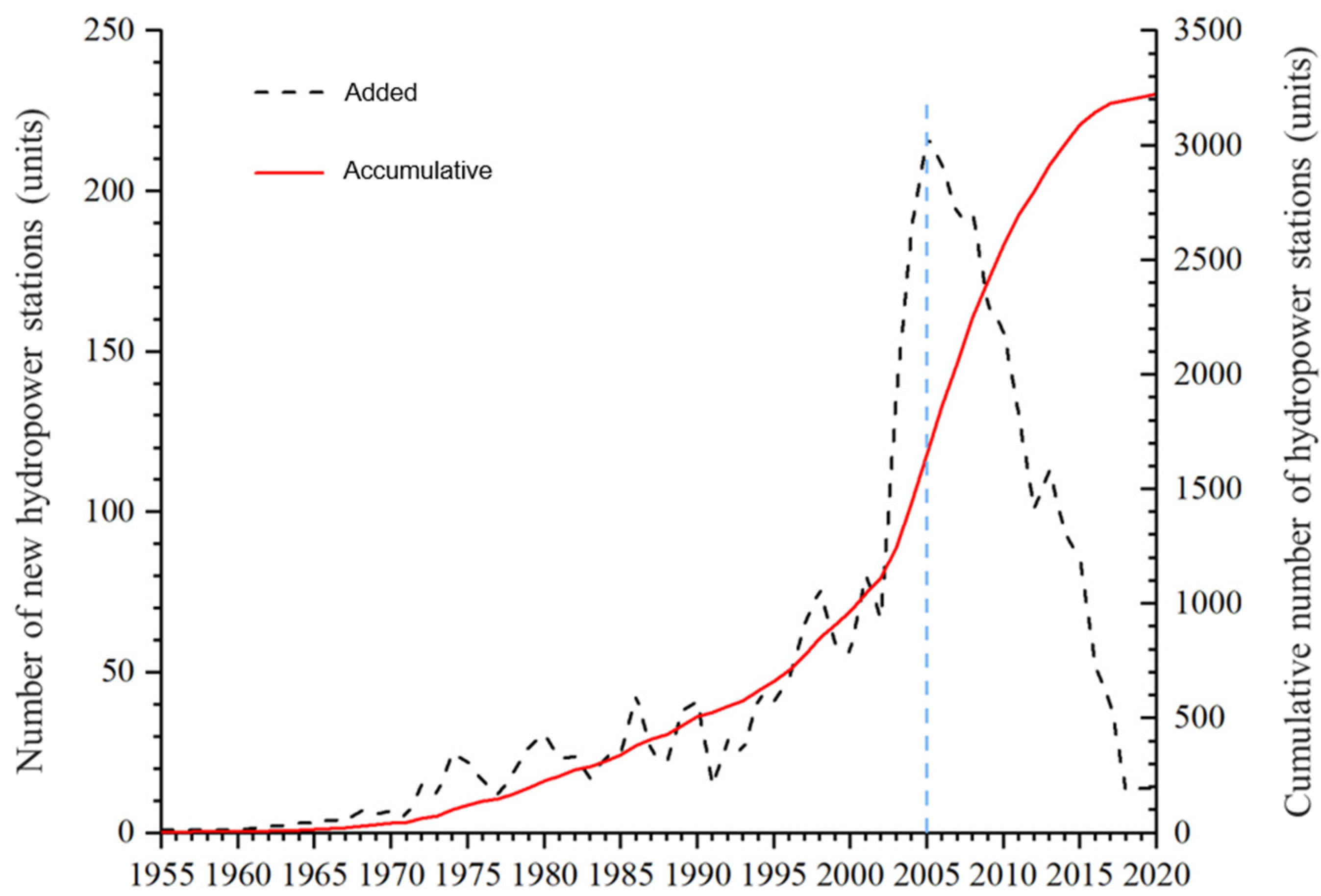
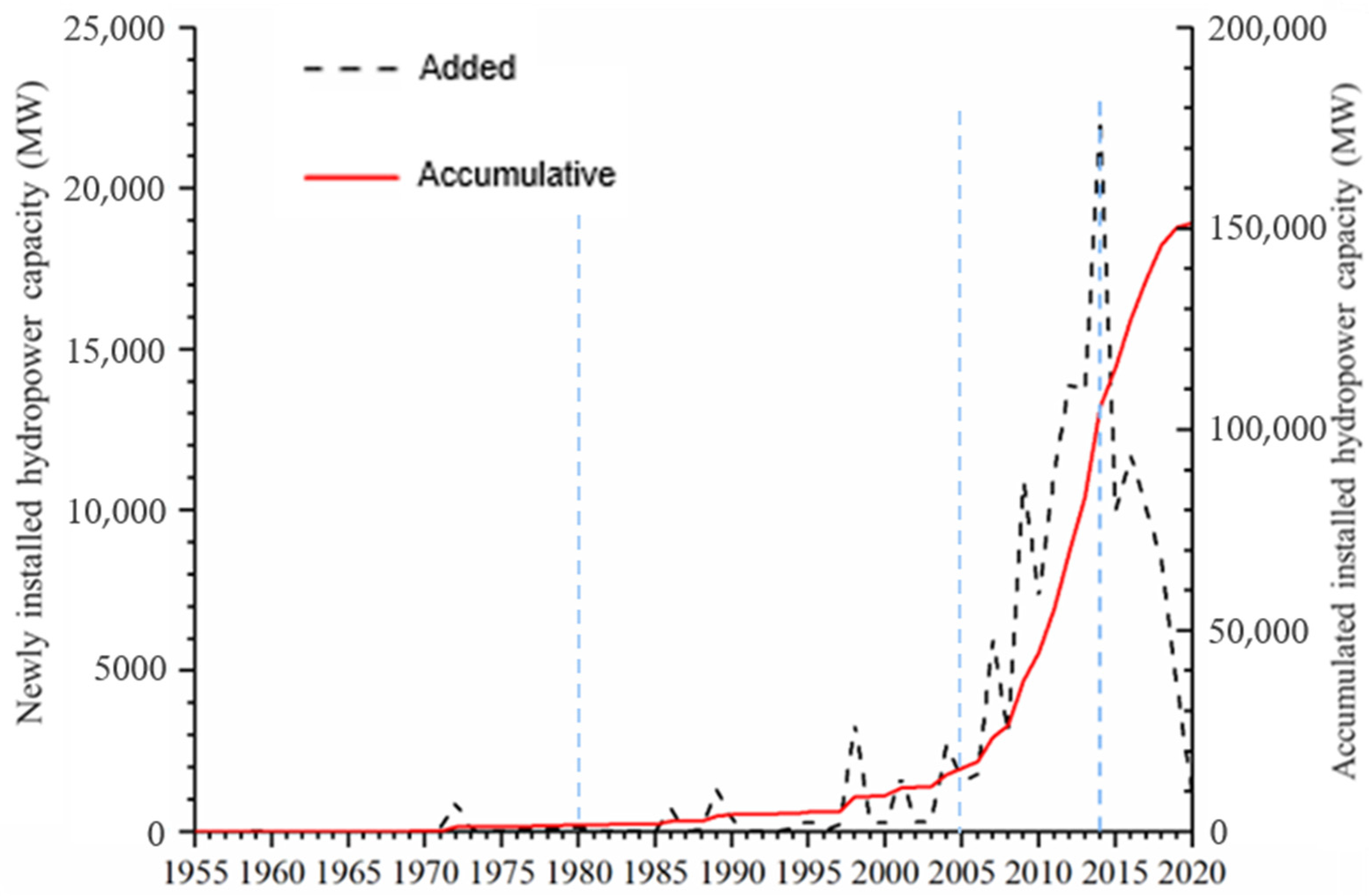

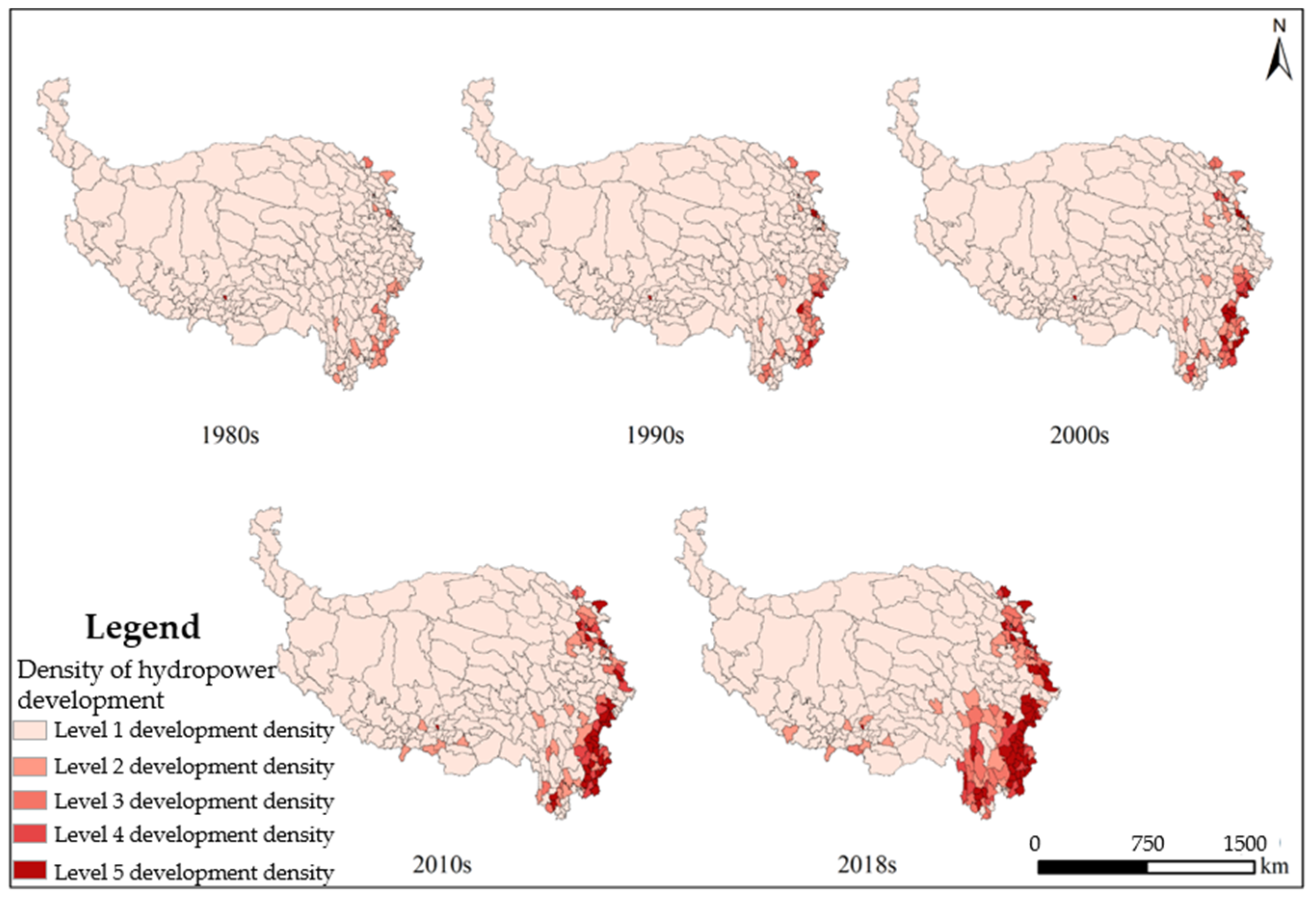
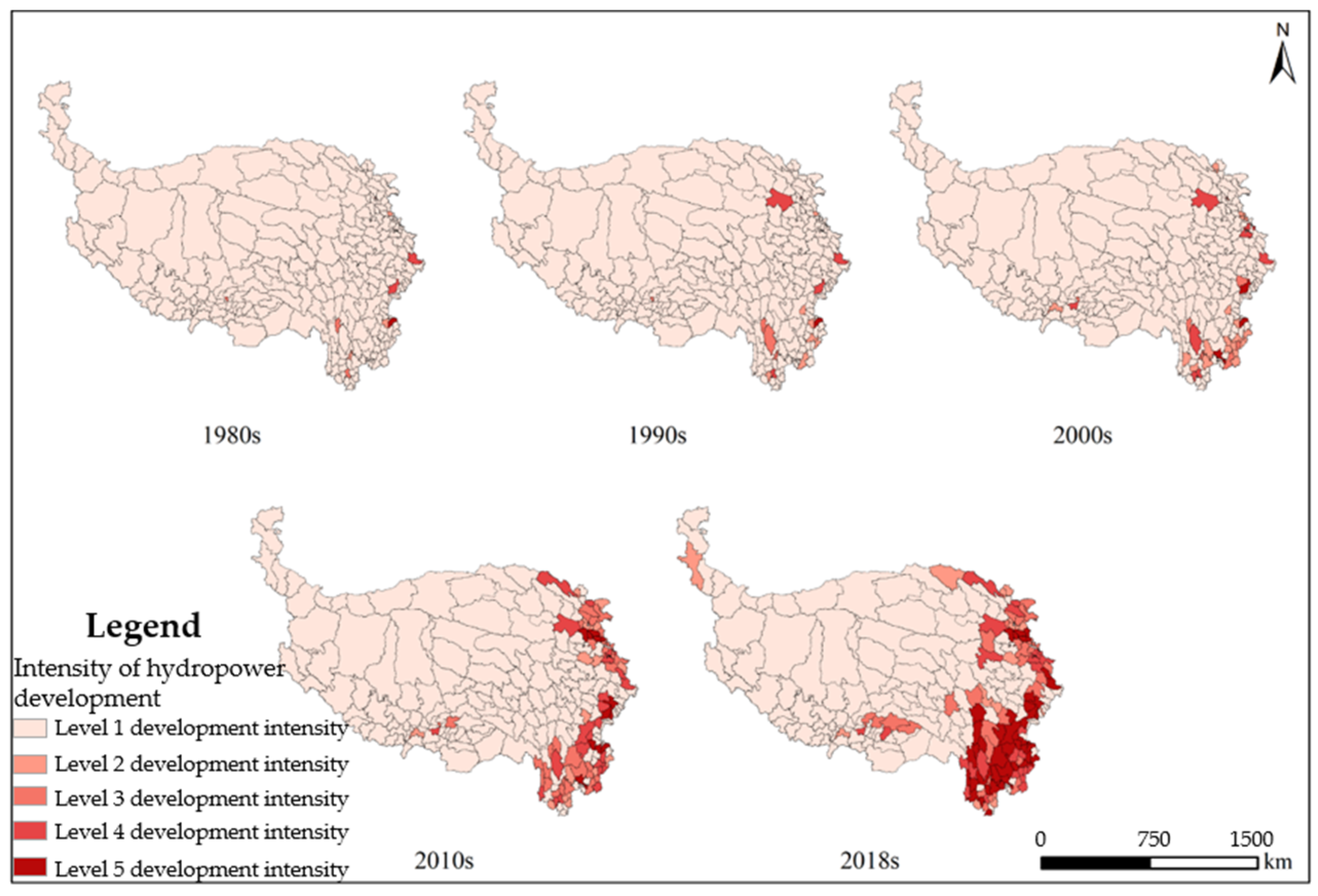
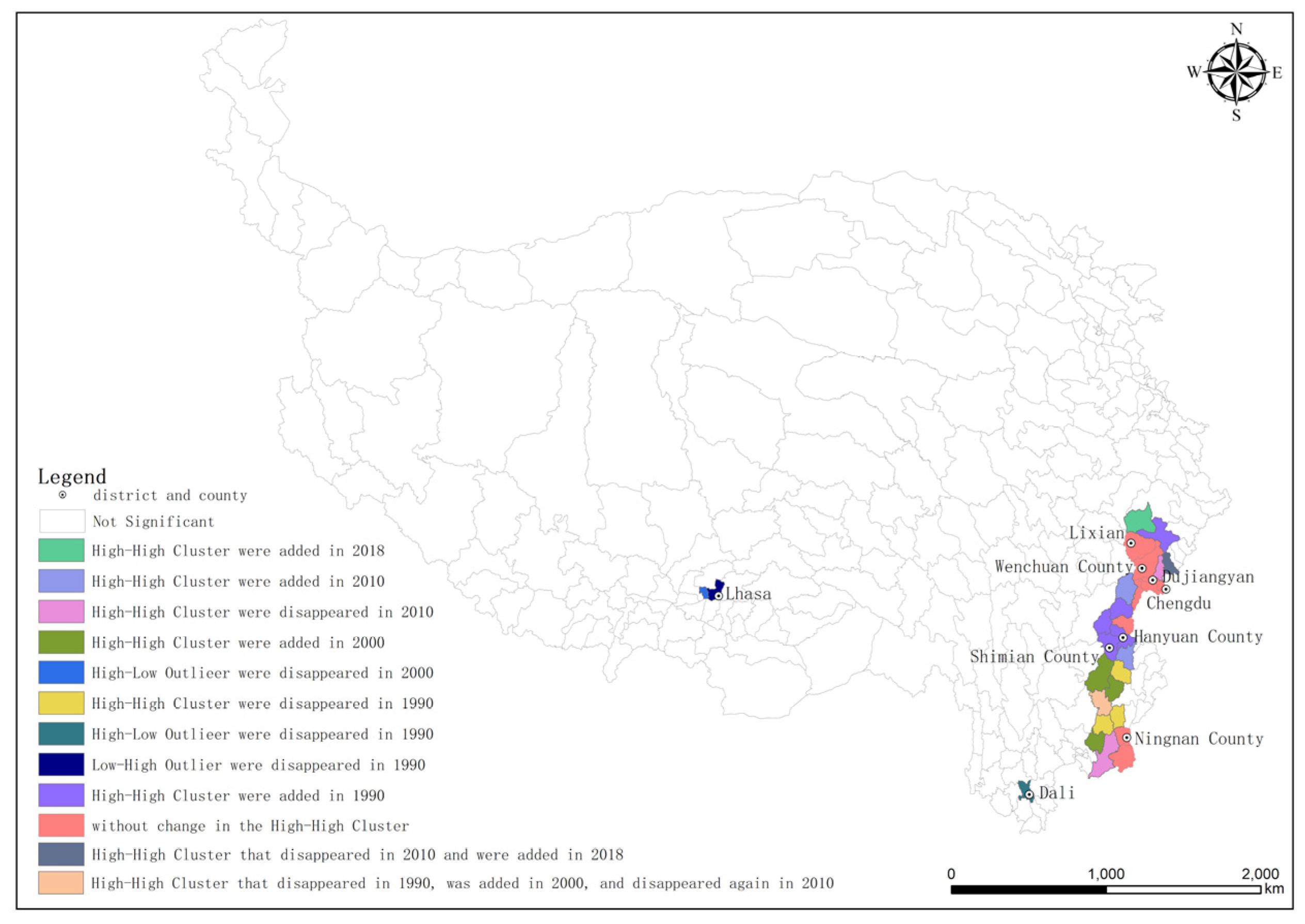
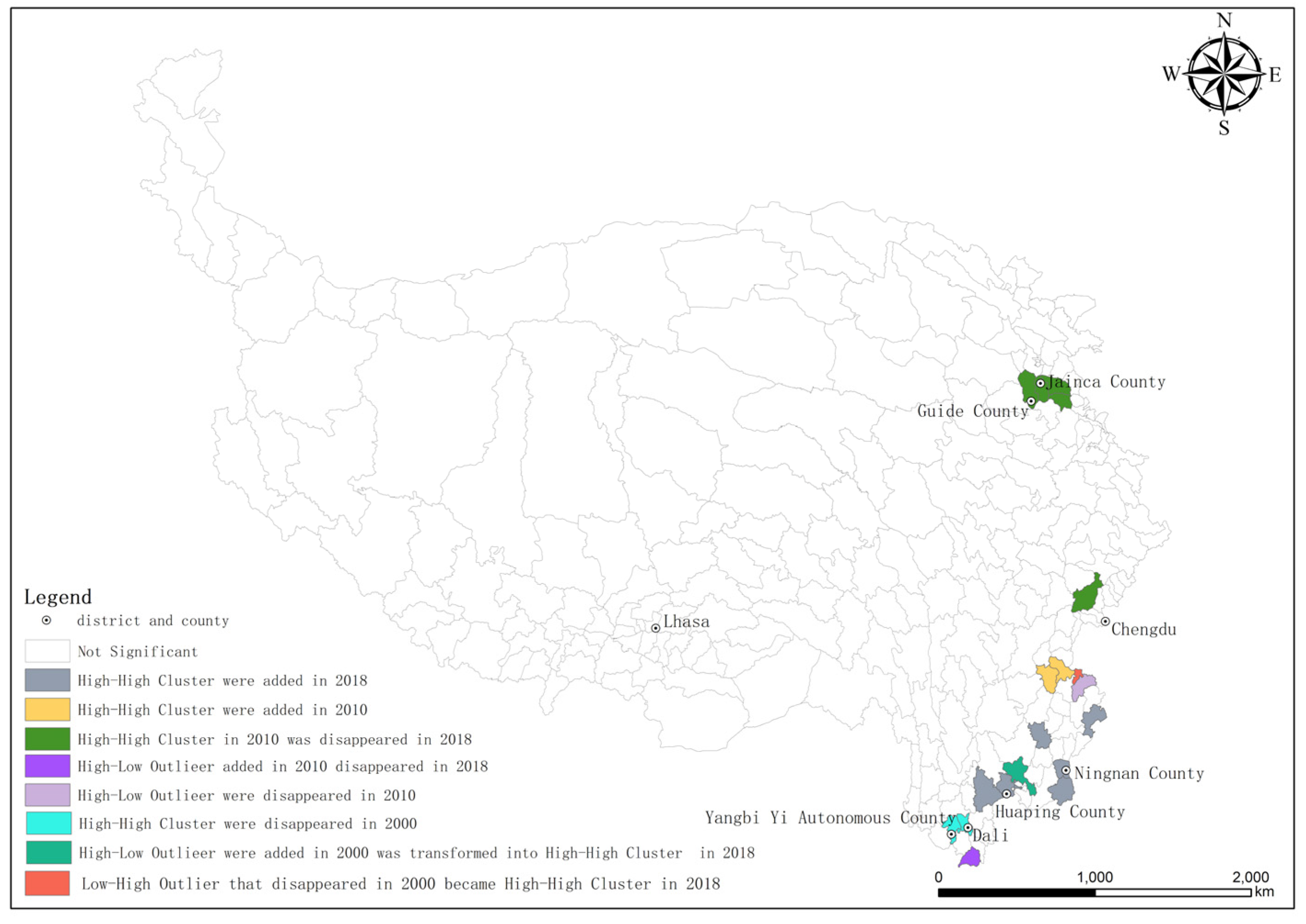
| Evaluating Indicator | Ⅰ Level | Ⅱ Level | Ⅲ Level | Ⅳ Level | Ⅴ Level | Reference Value (Sichuan Section of Dadu River) |
|---|---|---|---|---|---|---|
| I (MW km−2) | 0–0.004 | 0.004–0.010 | 0.010–0.046 | 0.046–0.172 | >0.172 | 0.24 |
| D (seat/km) | 0–0.002 | 0.002–0.004 | 0.004–0.008 | 0.008–0.013 | >0.013 | 0.034 |
| Index | Time | 1980s | 1990s | 2000s | 2010 | 2018 |
|---|---|---|---|---|---|---|
| Development density | I | 0.1033 | 0.2909 | 0.2476 | 0.2836 | 0.3113 |
| Z | 3.5824 | 9.4577 | 8.9634 | 10.2223 | 10.9906 | |
| P | 0.0003 | 0.0000 | 0.0000 | 0.0000 | 0.0000 | |
| Development intensity | I | −0.0054 | −0.0008 | −0.0100 | 0.0720 | 0.1489 |
| Z | −0.0708 | 0.1347 | −0.3693 | 2.6545 | 5.2061 | |
| P | 0.9435 | 0.8928 | 0.7115 | 0.0079 | 0.0000 |
Disclaimer/Publisher’s Note: The statements, opinions and data contained in all publications are solely those of the individual author(s) and contributor(s) and not of MDPI and/or the editor(s). MDPI and/or the editor(s) disclaim responsibility for any injury to people or property resulting from any ideas, methods, instructions or products referred to in the content. |
© 2023 by the authors. Licensee MDPI, Basel, Switzerland. This article is an open access article distributed under the terms and conditions of the Creative Commons Attribution (CC BY) license (https://creativecommons.org/licenses/by/4.0/).
Share and Cite
Qin, C.; Fu, B.; Zhu, X.; Dunyu, D.; Bianba, C.; Baima, R. Spatial and Temporal Patterns of Hydropower Development on the Qinghai–Tibet Plateau. Sustainability 2023, 15, 6688. https://doi.org/10.3390/su15086688
Qin C, Fu B, Zhu X, Dunyu D, Bianba C, Baima R. Spatial and Temporal Patterns of Hydropower Development on the Qinghai–Tibet Plateau. Sustainability. 2023; 15(8):6688. https://doi.org/10.3390/su15086688
Chicago/Turabian StyleQin, Chanyuan, Bin Fu, Xiaokang Zhu, Duoji Dunyu, Ciren Bianba, and Renzeng Baima. 2023. "Spatial and Temporal Patterns of Hydropower Development on the Qinghai–Tibet Plateau" Sustainability 15, no. 8: 6688. https://doi.org/10.3390/su15086688
APA StyleQin, C., Fu, B., Zhu, X., Dunyu, D., Bianba, C., & Baima, R. (2023). Spatial and Temporal Patterns of Hydropower Development on the Qinghai–Tibet Plateau. Sustainability, 15(8), 6688. https://doi.org/10.3390/su15086688







